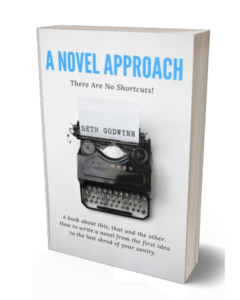Show or Tell
Seth Godwynn
When it comes to writing, there’s one convention that generally holds true. It’s common wisdom that you should show and not tell. Of course sometimes you have to tell, but as sweeping generalisations go, this one does make rather a lot of sense.

Telling is when the author, the narrator of the story, explains what’s going on, or what has led up to a situation. It’s when the story is explained to you with descriptions like:
‘The author lived in a small apartment, and at weekends, he stared at himself in a mirror, wishing he could turn back time.’
The narrator has just told us everything we need to know. It’s relayed to us the same way somebody might regale us a witty anecdote or tale. Before, we did not know the thing, and now we do. We have information we can use, but we didn’t experience it, so it’s unlikely we will care about it one way or another.

When an author shows you what’s happening, you’re pulled into the narrative as the action is brought to life around you. It’s something that you experience yourself. The same information as above could be shown to you like this:
‘The author awoke in his small, cluttered apartment, his phone awkwardly perched next to his bed on a pile of well-thumbed novels. “Saturday,” he groaned to himself. No work, no job to hide behind, two whole days to be productive with his writing.
He sat up, rubbing his hand over his short, cropped brown hair and caught his reflection in the dusty mirror. His eyes looked bloodshot and had thick black lines under them. “I think I’ve made a terrible mistake,” he said to himself with a sigh, as he returned his attention to his chaotically disorganised surroundings.’
In this example, rather than telling the audience the information, the narrator has shown you the events as they unfold. The information is the same, but in the second example the scene is alive, the characters are active, and the audience imagines them as if they too were in that very room with them.
A horrible example that illustrates the point perfectly comes from the television series, Star Trek. Many times in episodes of ‘The Next Generation’ and ‘DS9’, there would be an epic space-battle rendered as icons representing the various sides engaging on a monitor screen. While a dramatic, life or death struggle was going on outside, the viewers were shown tiny avatars moving backwards and forwards on a screen, as actors pretended, often unconvincingly, to be horrified.
The decision was clearly a result of budgetary constraints, but the hollow and empty experience leaves the audience feeling cheated. There’s no personal investment, no sense of drama, no connection to these events. They may as well not be happening.

Writing is far more critical, and you don’t have the excuse of budgetary limitations to hide behind. Your job, as an author, is to avoid cheating your audience. You have to draw them in and make them feel like the story is alive, and that they’re a part of the action, perhaps imagining themselves as your brilliant and well-written protagonist, or observing as an emotionally invested spectator.
Imagine your own personal experience of life. Luckily, and hopefully, you’re not a brain floating in a jar. A human-being is a complex organism with a mind, a body and consciousness. That body is full of chemicals and senses, electrical signals flowing back and forth to a mind that we can scarcely comprehend the extent of.
The human experience is meant to involve us living in the world, doing things for ourselves, touching, tasting, seeing, smelling and hearing the universe around us. Which is more real and more vibrant in your own mind, the last really excellent meal you had, or the time someone told you about a really excellent meal they had eaten?
It’s not as obvious as it sounds. The chances are that if someone described for you their experience of something they tried, then your immediate thought would be that you might like to try that for yourself. That’s simply how human beings work.
If we relate that to our writing, we have to engage the audience by taking them on a journey into the experience of our characters. We want them to vividly imagine what it’s like to be there, feeling the world as if it was real to them.
Telling the audience means that they know what’s happening, but they have no emotional investment in it—it has left no real impression on them. Showing the audience adds a dimension to the story. It makes it real, connects at an emotional level with the reader and makes the characters believable as people. The difference between the two ways of presenting the same information is obvious and noticeable, especially to the reader.
While it’s better to show the audience the action, rather than describe it, it’s sometimes unavoidable to take a slight shortcut. The author must tell the audience what’s happening to set a scene, and there will be times when a certain amount of exposition is preferable.
Fairy stories and fantasies often begin with a great deal of exposition, paragraphs of dull writing that set up the imaginary world where the story is set to take place. This is lazy writing and there really isn’t any excuse for it. It’s just as easy to take a character and have them experience the tale, revealing the layers of the environment to the audience as they happen or the effects of them are felt.
This is the domain of the infamous Star Wars word crawl, where long, tedious lines roll past the audience before the movie begins. A well-written narrative shouldn’t need this—it would be able to take the reader on a journey without having large, clunky sign-posts to mark the way.
As an aside, the Batman TV series from the 1960s deliberately subverted this principle to humorous effect, by placing quite literal large, clunky signs on just about anything it would take too long to describe via any other technique. The show broke a lot of rules like that, because the writers knew exactly what they were doing, and they probably wouldn’t have tried had it been any other show.

The important thing to master is judging how and when to utilising the different methods of presenting your story. As a simple rule of thumb, if something is happening, take the audience into it and engage them with the story. If you’re taking the audience into the scene, use the art of telling them simply to set the stage and let the action take it from there.
If there is no other way, they have a character tell another what the audience needs to know, but always keep it brief, say no more than needs to be said about it.
Keep the story moving and keep the audience engaged.
Many thanks for reading this article. We hope it was interesting, informative and entertaining. Follow us on social media or share our content on your own pages. It helps us grow so we can create more free content to help you.

